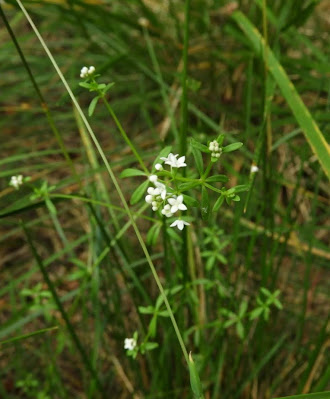Photography of such small flowers is a challenge!
Hedge Bedstraw, Galium album
This plant both sprawls and grows erect in a local hedge near Monmouth.
Large sprays of tiny (3-4 mm) white flowers thick along long branching stems make this colony very noticeable. It has the longest stems of these Bedstraws, up to 150 cm. The petals taper to a fine point.
The stems are smooth and square which can be seen here. The leaves also taper to a fine point. They show up clearly here against a laurel hedge.
Common Marsh-bedstraw, Galium palustre
Very common around the lake at Woorgreens Nature Reserve in the Royal Forest of Dean, this scrambles around the lake shore path. It has shorter stems than Hedge Bedstraw: up to 100 cm.
Heath Bedstraw, Galium saxatile
Abundant on the heathland at Beacon Hill, near Monmouth.
Forming mats, often with non-flowering shoots, the short leaves are in whorls of 5-8 with a fine point at the tip which can be seen here and forward pointing prickles on the edges which can't. I did see them with a 10x lens. It is quite low growing on Beacon Hill. Stems are four angled and between 10-30 cm long. It is the most compact of the Bedstraws in this post.
Lady's Bedstraw, Galium verum
Lady's Bedstraw comes with much folklore. Culpepper recommends its use to prevent or stop bleeding. It has a long history of being used in cheesemaking. The Greek physician and botanist Dioscorides in the C1st CE called it "galion" the milk plant and said it was a substitute for rennet. Lady's Bedstraw was named Cheese Rennet by Marion Golding, @nanny_MG on #Wildflowerhour recently. She is following in a long tradition. It was used across Europe for this purpose and Gerard, who was brought up in Cheshire, says it was used in Nantwich where the best cheese is made! Apart from its curdling action it also added colour.
Other names include Maiden's Hair in Yorkshire because of its colour and possible use as a dye or rinse and Fleaweed in Suffolk as it was reputed to keep fleas out of the mattresses in which it was used.
According to a medieval legend of Northern Europe Christ was born on a bedstraw of bracken and Galium verum and as one of the Cradle Herbs it may have been used in the manger. Plants with the word Lady in their names often have a link to the Virgin Mary. Certainly, it was widely used in bedding as its smell of honey when fresh, becoming the scent of hay when dry, made it an attractive addition to other stems.
It was also believed to ease childbirth: the relaxing perfume possibly being key here.
This has arrived in the wild area of my garden in the last few years and is now fairly well established. There are frothy masses of tiny bright yellow four petalled flowers. Leaves in whorls of 6-12 are strap-shaped with down-rolled margins and a tiny point at the tip.The stems are smooth and subtly four angled.
This brings to a close an account of the Bedstraws I have seen recently in sun, rain and cloud!
Acknowledgements
I am indebted to Stace 4, Harrap's Wild Flowers, Grigson The Englishman's Flora and website http://botanical.com/ A Modern Herbal by Mrs M Grieve










No comments:
Post a Comment